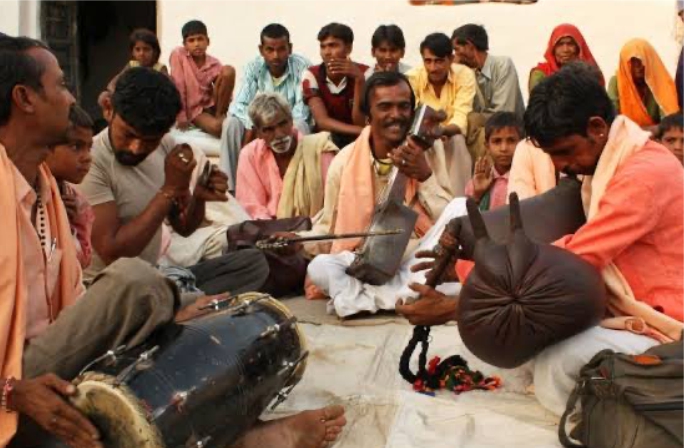


The Jogi community are followers of the Nath sect. Thus, the community people are also referred to as Nath along with Jogi. Nath is a more generic term to represent the community which follows certain rules and regulations set by their guru. Jogi is also a colloquial term for Yogi—a man who religiously practises Yoga as a means of meditation and spiritual enlightenment. Gradually, as the groups of Nath expanded and divided into different sects, it led to the formation of a large community, and subsequently, it became a distinct caste. But in this article, I would prefer to refer to them as a community.
In general, Jogis are identified as world-renouncers having supernatural powers. Many among them live the lives of ascetics. The religion and philosophy as set out by different sects form the main basis of their practices and life discourse.
The Jogi, who have been documented in the village Banda (in Sawai Madhopur district), are householders, live alongside the other castes of Meena tribe—potters and barbers. In total, there are 250 households of Jogi indicating a population of around one thousand five hundred. Apart from this, the householder Jogi are also spread over nearby villages like Boli, Sirohi Jhonpada, Bhagwatgarh, Barwada, Lorwada-Jhatwada, Kondadi, Dwada, Gonjiyari, among others that fall in the Sawai Madhopur district. The Jogi of Banda belong to the Pav Panthi sect (of Jaipur), out of the twelve different sects of Jogi. They have migrated from Niwai, seventy-five kilometres south of Jaipur.
In Alwar, an entirely different caste of Jogi exists, consisting of Meo or converted Muslims. The repertoire of these Jogis’ consists of the Hindu songs patronized by the Hindu castes in the region, but their style of singing is entirely different. Instead of the stringed instrument like sarangi (string instrument), they use single string bhapang (percussion instrument made of hollow shell of dry pumpkin mounted with goat-skin). They also sing life stories of Rama and Hanuman, unlike the Hindu Jogi.
The community falls in the category of professional musicians and is patronized by the local rural communities, who invite them during the auspicious Hindu months for night jagarans (night awakenings). Jogi are worshippers of Shiva, who is considered as Adi God (primitive god). Thus,
the life of Shiva finds its place in their repertoire. One of the important ballads that they sing around Shiva’s life is Shiv-Parbati Ka Byavla illustrating the challenges of marriage of Parbati with Shiva. Another ballad related to Shiva’s life is Shivji Mahrya. Similarly, Narasimha-ki-Katha is also sung by them. Narasimha is an incarnation of Vishnu, who is part-lion and part-man.
After Shiva, the tales of saints or the Rajput warriors and rulers, who renounced the world and had become ascetics, find mention in these ballads. Some of the ballads which are sung around these saintly figures are Raja-Bharthari-ki-Katha and Raja Gopi Chand-ki-Katha. Bharthari and Raja Gopichand are said to be related as uncle-nephew. Jogi also sing tales of generous dacoits, one such being Dukha Dahadi-ki-Katha. A story of two brothers called Roop Basant-ki-Katha is also sung by them. Some of the Jogi also sing Baba Ramdev-ki-Katha (also known as Ramdev Pir, a Hindu folk deity of western Rajasthan who was a ruler during the fourteenth century A.D.), and tales of their holy saints like Baba Guru Gorakh Nath, Baba Jalandar Nath, and others.Shiv-Parbati Ka Byavla is the longest ballad that takes about three to four nights to complete. The rest could be completed within one night. Compositions of these ballads are in the form of prose and verses in couplets of four to six lines. First the prose parts are narrated by the lead singer while the verses are sung by the group whose main line is initiated by the lead singer. Proses are explanatory of what is sung in the verse. The story progresses likewise with the help of supporting singers who either make exclamatory sounds in agreement or repeat the lines sung by the lead singer. In between the sessions, the musicians take rest, smoke bidi, chew tobacco and drink tea served by the patrons.The group of Jogi musicians consists of six to eight members who sit in a circle and sing in tune to the accompanist instruments like—pungi or mashak (wind instrument), which is an indigenous bagpipe made of goat skin. Sarangi or jogiya sarangi is a string instrument generally played by the lead singer. Khanjari (percussion ), set of manjira (metallic clappers) and sometimes dholak and harmoniums are played by the accompanist singers. In this particular recording of Raja Bharthari-ki-Katha, dholak and harmonium have been avoided as those are not traditional musical instruments of Jogi. A long tong shaped chimta is also used and clapping is common when the performance reaches its peak.